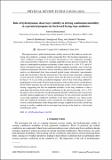Role of hydrodynamic shear layer stability in driving combustion instability in a premixed propane-air backward-facing step combustor
Author(s)
Hemchandra, Santosh; Shanbhogue, Santosh; Hong, Seung hyuck; Ghoniem, Ahmed F
DownloadPhysRevFluids.3.063201.pdf (1.091Mb)
PUBLISHER_POLICY
Publisher Policy
Article is made available in accordance with the publisher's policy and may be subject to US copyright law. Please refer to the publisher's site for terms of use.
Terms of use
Metadata
Show full item recordAbstract
This paper presents a global hydrodynamic stability analysis of flow fields in a backward-facing step combustor, assuming weakly nonparallel flow. The baseline experiments in a “long” combustor of length of 5.0 m shows the presence of two combustion instability states characterized by coherent low- and high-amplitude acoustic pressure oscillations. The analysis is performed for propane-air mixtures at three values of ϕ=0.63, 0.72, and 0.85, which correspond to quiet, low-amplitude and high-amplitude instability states in the long combustor experiments. Base flow velocity and density fields for the hydrodynamic stability analysis are determined from time-averaged particle image velocimetry measurements made after the length of the duct downstream of the step has been shortened to eliminate acoustic pressure oscillations. The analysis shows that the shear layer mode is self-excited for the ϕ=0.72 case with an oscillation frequency close to that of the long combustor's fundamental acoustic mode. We show from an analysis of the weakly forced, variable density Navier-Stokes equations that self-excited hydrodynamic modes can be weakly receptive to forcing—suggesting that the low-amplitude instability in the long combustor is due to semi-open loop forcing of heat-release oscillations by the shear layer mode. At ϕ=0.85, the analysis shows that the flow is hydrodynamically globally stable but locally convectively unstable. Spatial amplification of velocity disturbances by the convectively unstable flow causes high-amplitude combustion instability in the long combustor case. These results show that combustion instability can be sustained by two different mechanisms by which acoustic and hydrodynamic modes being either strongly coupled result in fully closed loop forcing, or weakly coupled result in semi-open loop forcing of the flame by a self-excited hydrodynamic mode.
Date issued
2018-06Department
Massachusetts Institute of Technology. Department of Mechanical EngineeringJournal
Physical Review Fluids
Publisher
American Physical Society
Citation
Hemchandra, Santosh et al. "Role of hydrodynamic shear layer stability in driving combustion instability in a premixed propane-air backward-facing step combustor." Physical Review Fluids 3, 6 (June 2018): 063201 © 2018 American Physical Society
Version: Final published version
ISSN
2469-990X
2469-9918